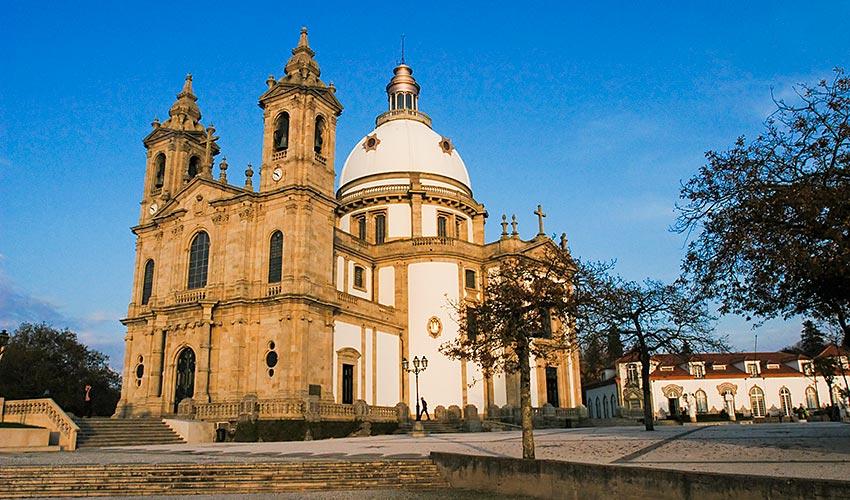Braga is situated in the heart of the fertile Minho province in north-western Portugal, surrounded by a gently rolling landscape of mountains and forests. One of Portugal's main religious centres, the city is renowned for its baroque churches, splendid 18th century houses and beautiful parks and gardens. The old city is solemn and antique, although industry and commerce have brought a modern way of life, complemented by local universities, contemporary restaurants and lively bars. On Thursday mornings, Braga hosts the largest market in the region, with stalls selling everything from fresh produce to traditional ceramics.
The city’s history is evident in its numerous churches and monuments, the principal landmarks including the striking Sé Cathedral and the 17th-century church of Santa Cruz. On a hill about 5 kilometres (3.1 miles) south-east stands the sanctuary of Bom Jesus do Monte, which is an important pilgrimage site. Beyond it is Mount Sameiro, where a colossal statue of the Virgin Mary overlooks the city. A short drive from Braga, the Citânia de Briteiros is an impressive archaeological site from the Iron Age.
Beautiful, wild beaches can be found along the coast in Esposende, Ofir and Apúlia. The whole district is famous for its festivals and local gastronomy, boasting traditional recipes include codfish (cooked in hundreds of different ways) and oven-roasted duck with rice.
Places to see
Sé Cathedral (Braga)
In the historic centre of Braga stands the oldest cathedral in Portugal, the Sé, containing a wealth of sacred art treasures. Building began in 1070 and was influenced by a combination of Gothic, Renaissance and baroque styles. Highlights include the ornate Manueline towers and roof, as well as the carved altarpiece and twin baroque organs. The tombs of Dom Henrique and Dona Teresa, parents of the first King of Portugal are located in the Capela dos Reis (Kings’ chapel).
Santuário do Bom Jesus do Monte (Bom Jesus do Monte Sanctuary) (Braga)
This spiritual sanctuary is considered one of the most beautiful in Portugal. Surrounded by magnificent gardens, the neoclassical church was designed by Carlos Amarante in the late 18th century. The famous baroque stairway zigzags up to the church, featuring enchanting fountains and statues along the way. Visitors can also take the funicular (cable car) or drive to the top to enjoy the peaceful ambience and outstanding views.
Citânia de Briteiros (Briteiros citadel) (Briteiros)
One of the best preserved archaeological sites in the Minho is the Citânia de Briteiros, the ruins of a Celto-Iberian settlement dating back to 300 BC. Archaeologists have discovered the foundations of more than 150 round stone huts, paved roads, cattle sheds and water conduits. Two huts have been reconstructed on site and fascinating relics are on display at the Museu de Martins Sarmento in Guimarães, including painted pottery, carved stones, weapons and jewellery.
Igreja de Santa Cruz (Santa Cruz church) (Braga)
Built in the 17th century, the Santa Cruz church boasts an intricate stone façade and was designed in a baroque mannerist style. The elaborate interiors include intricate gold carvings on the organ and pulpits, a high nave and beautiful azulejo panels.
Jardim de Santa Bárbara (Santa Bárbara Garden) (Braga)
The Santa Bárbara Garden is one of the most beautiful in Portugal. Dating back to the 17th century, this elegantly landscaped square is located near the former Archbishop’s Palace and features colourful flowers, lush plants and extraordinary topiaries.
Ruínas romanas de Bracara Augusta (Roman ruins of Bracara Augusta) (Braga)
The ruins of Bracara Augusta can still be seen today, a city founded by Emperor Augustus between 300 BC and AD 400. It became the Roman capital of northern Iberia and was later occupied by Visigoths and Arabs. Since the 1970s, efforts have been made to preserve the complex archaeological structures that still remain.

 English
English  Português
Português  Deutsch
Deutsch 



